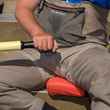If you’ve kept up with comments on the first installment of “Trans-Angler,” you’ll note that my ECHO fly rod and reel arrived courtesy of UPS on the very day that story published. I wish I had some insightful comments about ECHO products, but as a newbie all I can offer is that they look cool. The ION reel looks like a quality piece of work and I really like the deep blue color of my BASE 6 weight rod. The package arrived after sundown so I could only play with the reel and try to calm my wife’s fears as she looked upon the newest reason why “I’ll be home after dark” will be my parting words for spring, summer and early fall treks to water in the coming year.
The following morning, I was in the yard with the tailgate down and the iPhone working, searching for ideas about which knot to tie where. Of course I knew about the improved clinch, the standard of all fishing knots, but I was looking for a way to attach backing to line and line to leader before I even thought about tying on a fly. Airflo line has loops, but I still had to figure out how to attach it the backing, which did not have loops. As a scoured the interweb for ideas, I came across a knot that I’d first heard of years ago while reading about saltwater fly anglers — the Bimini twist. It sounds like a dance move, but it also sounds like a knot that I needed to know. So I attached backing to line with a Bimini twist on only the second try. And even though an experienced fly angler I know (one who has since revealed that he can't tie a Bimini) made a snide comment about the knot being overkill, I feel like a better man for having learned and tied it.
After spooling up, I did a loop-to-loop connection from line to leader and tied on a tiny piece of white pipe cleaner as my fly. Then it was on to my best Brad Pitt impersonation because he’s about the only fellow I’ve ever watched cast a fly rod. That didn’t work out well. So I went to the ECHO website and watched a Tim Rajeff video. I don’t know a lot about Tim, but a quick Google search revealed that he is a master of the craft. Long story short, Tim’s paint brush demonstration clarified what I should be striving for. My casting improved and a mental review of what happened during a bad cast usually revealed that I wasn’t flicking water off the paint brush.
But in the loading and casting of a fly rod there is something more than mechanics of the action, something more than physics. I don’t know exactly what that something is. Like other skills that require a blend of refined technique and rhythm, there is a distinct physical sensation when you get it right. I talked about this with my neighbor when he asked how they were biting in my front yard, and the best analogy I came up with was shooting a basketball and shooting a bow instinctively. You know you’ve made a good shot the moment the ball leaves your fingertips or the arrow leaves the string because it feels good. Likewise, I knew the loop was tight (I pick up on jargon quickly) and the line would lay down a gentle path for leader and fly to follow when my left hand was simply conduit and my right hand a metronome. In those perfect moments, cord swooshed through guides and it all felt good. It felt right.
And so I killed about 12 hours over the next few days casting to leaves and twigs in my yard. I fished for my cat. I got hung up on branches and popped the leader a few times when I didn’t wait on the back cast to unfurl. Knots magically appeared on my leader while I was casting. Still trying to figure that one out.
Steep learning curve aside, what I discovered in the yard under a weak December sun was that casting the fly rod was a joy in itself. It offers synergy — something more than the sum of parts. It creates a point where human and tool become indistinguishable. And, though I’m not there yet, I believe it offers something approaching the mindfulness yet mindlessness of zen.
Was that too deep and wide? If so, grab a wading stick and come on in anyway because there’s more to this thing than slinging line and catching fish. You’ve probably already felt this, but maybe that feeling has been buried under finding just the right combination of leader and tippet. Maybe it has been buried under myriad fly patterns and technical specifics. If so, I invite you to see your sport, your passion through the eyes of a beginner. Just a limber rod and whispering line along with a melding of biomechanics and gut feeling. Put it all together and I’m looking at my newest addiction. Adding water and fish will likely push it to obsession.































Comments
Datmaximus replied on Permalink
Great article, good to know someone else is on the same path I am. I am still logging hours in the front yard and realizing this is quickly becoming an obsession. I caught my first fish on a fly line about 2 months ago (right before freezing temps of southeastern Idaho set in) and have been skunked once since. Pulled out a 19 in bow in 6 degree weather last week, probably 75% of the river was frozen. Even though I spent 4 hours in freezing weather for that fish (and a handful like it on previous trips) it was completely worth it. Like this article says, every cast is a step toward zen. I have been a spin-fisherman for years, but taking fish on a fly rod is beginning to be all I think about and my spinner rod is collecting dust. Thanks to hatchmag for helping me pass the time between trips to the river!
Pages